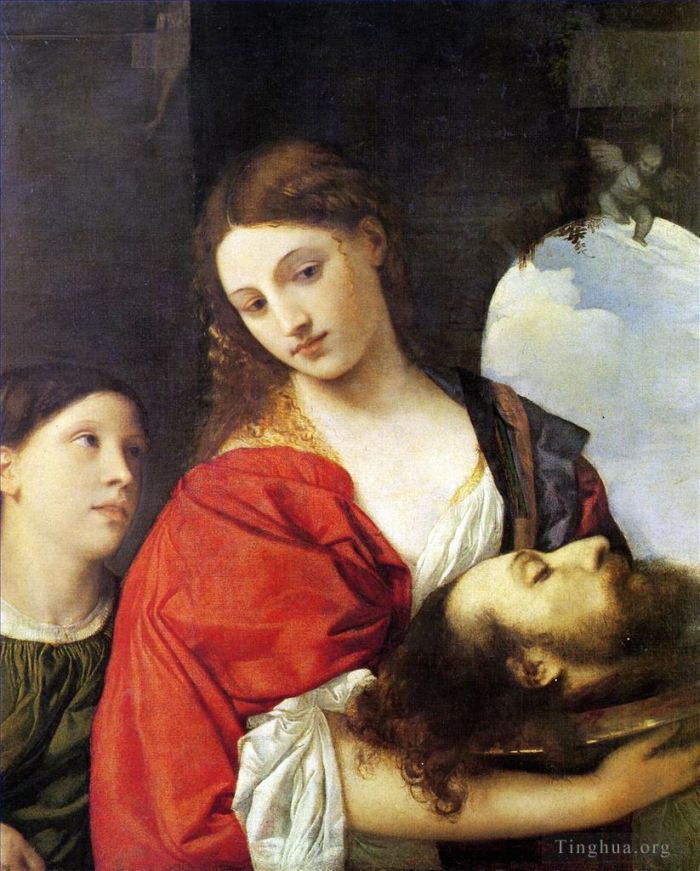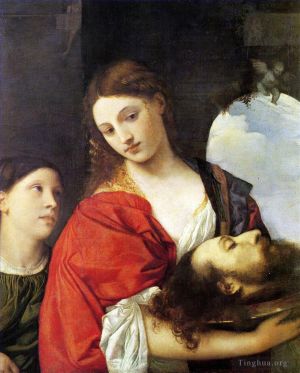Salome 1512
Titian
- Price: Price on Request
- Art Type: Oil Painting
- Size:
- English Comments: 0
- International Comments: 0
- Creating Date:
- Introduction and Works of Titian >>
Keywords:
Salome
Work Overview
- Salome
Artist Titian
Year c. 1515
Medium Oil on canvas
Dimensions 90 cm × 72 cm (35 in × 28 in)
Location Doria Pamphilj Gallery, Rome
Salome is an oil painting, probably of Salome with the head of John the Baptist, by the Italian late Renaissance painter Titian. It is usually dated to around 1515 and is now in the Doria Pamphilj Gallery in Rome. Like other paintings of this subject,[1] it has sometimes been considered to represent Judith with the Head of Holofernes, the other biblical incident found in art showing a female and a severed male head .[2] Historically, the main figure has also been called Herodias, the mother of Salome.
Sometimes attributed to Giorgione, the painting is now usually seen as one where Titian's personal style can be seen in development, with a "sense of physical proximity and involvement of the viewer", in which "expert handling of the malleable oil medium enabled the artist to evoke the sensation of softly spun hair upon creamy flesh".[3]
Erwin Panofsky suggested the head of John the Baptist might be a self-portrait,[4] and it is possible that Titian was alluding to his private life with the model, anticipating Cristofano Allori's, Judith with the Head of Holofernes (1613, Royal Collection, and other versions), where the severed head was a self-portrait and Judith and the maid portraits of his ex-mistress and her mother.[5] The model here, allowing for a degree of idealization, has been said to be the same used in the Dresden Venus (Giorgione and Titian, c. 1510).[6]
This composition was copied many times, in some cases at least by Titian's workshop.
The possible provenance of the painting begins in 1533, with a Judith by Titian recorded in the collection of Alfonso I d'Este, Duke of Ferrara, a very important patron of Titian. No other surviving Titian painting seems to fit this record, so if it is not the painting now in Rome, it must be lost.[8] In 1592 Duke Alfonso's grand-daughter, Lucrezia d'Este (1535–1598) owned a painting described as a "Herodias" (Salome's mother).[9] What is certainly the Doria Pamphilj painting belonged by 1603 to Cardinal Pietro Aldobrandini before passing to his niece Olimpia Aldobrandini, whose second husband was the ex-cardinal Camillo Pamphilj; since then it has passed by descent through the family.[10] In the 18th century the painting was called a Herodias, but a number of foreign visitors who saw it record thinking the main figure to be Judith.[11]
If the painting's main figure was Herodias, traditionally seen as the prime mover of the conspiracy to get John the Baptist executed, the younger woman next to her would be intended to represent her daughter Salome,[12] here shown as a figure in thrall to her more glamourous mother. The identification as Herodias seems to have no recent supporters, but that as Judith does.[13]
A medieval addition to the Salome legend held that, as well as her mother's hatred of John for his preaching against her, Salome was also motivated by a frustrated love for John, to which the cupid might refer.[14] Her face is turned away from his head, but her eyes look back to it. Panofsky describes her as: "Meditative, sad and a little benumbed, she seems to recoil from the face of St. John which yet attracts her sidelong glances with irresistible force". Meanwhile, the maid "looks at the heroine with the eyes of a faithful dog who feels and shares his master's distress without comprehending its cause".[15] Thus, in the pyramidal group of figures,[16] the glances flow from the maid on the left, up to Salome at centre, and down to John at right, whose dead eyes are closed.
The use of erotic allure on male figures of power is the core of both stories, but to the church and Titian's contemporaries, Herodias and Salome were bad, but Judith a heroine.[17] Both stories were part of the repertoire of the Power of Women topos, mainly a feature of German art in this period, but whose subjects were also depicted in Italy.[18] The small Cupid at the top of the arch reinforces the eroticism of the treatment, suggesting either Salome's lust for John,[19] (or Herod's implied attraction to Salome) or that of Holfernes for Judith,[20] according to choice. It has also been suggested that the use of cupids on the keystone of arches was common in public buildings of the period in Venice, which "stresses the official nature of St. John's imprisonment and execution".[21]
The presence of a maidservant is usual in depictions of Judith (following the Book of Judith, which mentions her), but not in those of Salome with the head of John the Baptist.[22] On the other hand, the head on a dish is normally associated with Salome's story, and is mentioned in the gospel,[23] while Judith often puts hers in a sack, or carries it by the hair, both also following the text of their story.[24] A single lock of hair falling over the face was considered highly alluring, and associated with courtesans, perhaps suggesting Salome is indeed the subject,[25] though Judith is described as using every effort to dress seductively.[26]
The murky background at the left includes a fitting at the top, between the two womens' heads, which is described as a lock by Panofsky, though it might be a hinge also.[27] This marks the vertical edge of a zone with a slightly different tint, perhaps showing the transition from a door to a wall. What could be an iron bar, or door top, is to the left of the fitting. The Pasadena version also shows a fitting and change in colour. This suggests the paintings show the women leaving the prison where John was killed, to return with the head to the head to Herod's feast, a version of the story often shown in art, though not exactly following the gospel, in which a soldier presents the head on a dish to Herod, who gives it to Salome, who in turn gives it to her mother.[28] The biblical text is very clear that Holofernes is assassinated in his tent in his camp, and the scene (rare in art) where Judith shows the head to the people of Bethulia happens at night inside the city gate, so the background of the painting is difficult to reconcile with a depiction of Judith.
Attribution and date[edit]
As with other small Titians from the 1510s, the attribution has wavered over the centuries, beginning with Titian in early records, but (almost inevitably) becoming attributed to Giorgione by the 19th century, until Crowe and Cavalcaselle attributed it to il Pordenone. By the end of that century it was once again attributed by most to Titian, which has remained the usual view among experts.[29]
The Norton Simon Museum version was attributed to Titian in sales in England between 1801 and 1859, but a sale in London in 1891 called it a Giorgione.[30]
Though a date of about 1515 has long been the usual view, purely on stylistic grounds, Charles Hope has suggested about 1511. This is partly because of its relationship to Sebastiano del Piombo's Salome of 1510 (National Gallery), where the setting also moves from dark at the left to light at the right.[31] This has also been regarded by some as a "Judith".
- Copyright Statement:
All the reproduction of any forms about this work unauthorized by Singing Palette including images, texts and so on will be deemed to be violating the Copyright Laws.
To cite this webpage, please link back here.
- >> English Comments
- >> Chinese Comments
- >> French Comments
- >> German Comments
- >>Report
- Noli me Tangere 1511
- Clarice Strozzi 1542
- The Rape of Europa
- Venus with a Mirror
- Federigo Gonzaga Duke of Mantua
- Portrait of a Woman calledLa Schiavona
- Vanitas 1515
- Violante
- Assumption of the Virgin
- Flora
- The fall of man 156nude
- Salome 1555
- Danaë
- Jupiter and Anthiope Pardo Venus
- Man with Gloves
- Portrait of Jacopo Strada
- Bacchus and Ariadne
- King Philip II
- Mary with the Christ Child
- The Bravo
- Madonna detail
- St Jerome
- Portrait of a Man 151The Met
- Entry of Mary into the temple 1534
- Saint Christopher
- Portrait of Marcantonio Trevisani
- Pieta
- Portrait of an Old Man Pietro Cardinal Bembo
- The Worship of Venus
- Profane Love or Vanity 1514
- Feast of the Gods
- Empress Isabel of Portugal
- Crowning with Thorns
- Venus and Adonis
- Self Portrait
- Sacred and Profane Love
- Portrait of a Man in a Red Cap
- The Emperor Charles V at Mühlberg (Equestrian Portrait of Charles V)
- Bacchanal 1523
- Woman in white 1555
- Christ Crowned with Thorns
- Venus Blindfolding Cupid nude
- Portrait of Pope Paul III
- Madonna with Saints and Members of the Pesaro Family detail1
- Saint Mark
- Salome 1512
- Venus with an Organist and Cupid (Venus and Musician or Venus with an Organist and a Dog)
- Pope Paul
- Annunciation
- The Last Supper
- Assumption detail
- Portrait of Count Antonio Porcia
- Saint John the Baptist
- Philipp II as Princedetail
- Venus of Urbino
- Tintoretto The Tribute M
- Suicide of Lucretia 1515
- Danae 154nude
- Portrait of Pietro Aretino
- Tintoretto Pope Alexander IV Presenting Jacopo Pesaro to St Peter
- Portrait of Ranuccio Farnese
- The Speech of Alfonso dAvalo 1540
- Portrait Ariosto
- Saint Mark Enthroned
- Pope Paul III and His Grandsons
- Portrait of Charles V Seated
- Portrait of Philip II
- The Gypsy Madonna
- The Three Ages of Man 1511
- Mater Dolorosa
- Titians daughter Lavinia 1560
- Philipp II as Prince
- Pesaro Madonna









 Singing Palette
Singing Palette